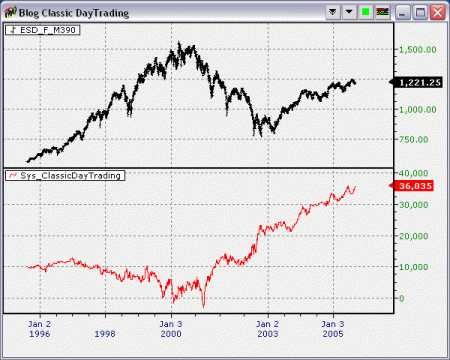Classic Day Trade Modelling
Before we have access to intraday day data, how do we test trading systems that last only a day?
Long time ago, thats all we have access to, and I think it is a good idea for our readers to see how traders utilize classic bias without the help of intraday data in creating day trading systems.
Discovering Basic Daily Bias
Basic bias usually happens when there is some fundamental or systematic behaviour in real-life that dictates the human factor in the market participation mechanism. For example, the economic data reporting is now concentrated in Tuesday and Friday since 1999. Thus it is obvious that these two days are less likely to behave predictably comparing to the rest of the weekdays.
Here is a trading system that long on Monday, Wednesday, and Thurday if the trading day before is a down day (taking advantage of mean reverting behaviour of the index), Classic Day Trading. For the rest of the week, it will short on Tuesday and Friday if the market is up on the previous trading day. This system employs a 5-day average range as the stop threshold. 2 deviation of the average range from the previous day close is used as the stop loss point.
In general, the system works like the chart below,
The System Behaviour
Lets take a look at the behaviour of the equity curve in detail,
This system does not perform before US Federal Reserves concentrating its economic reports in Tuesday and Friday before year 2000. Isn’t that interesting that this system is doing very well during the extremely bearish period in year 2000 to 2002? If price movement is distributed normally, shouldn’t the system perform poorly in general?
For a discretionary daytrader, who has a keen sense of market behavoiur, he/she would have adapted to the changes shortly after the sudden change in market behaviour since middle of year 2000.
If you are a mechanical system trader, you have to notice this fundamental change from the news so that you are aware of the change and understand that it will affect the market behaviour so drastically that you have to modify your existing systems to adapt to the change. Anyone who does not monitor the market closely will not survive this shocking change.
Summary
Since publishing Formula 301 #1 many readers requested for more information about the reasoning behind the Tuesday and Friday filter. That pushed me to write this article on the change of behaviour of our market today. It is not beautiful to work in an environment like what we are dealing with today, that change quickly and furiously.
To stay one step ahead, we have to pay attention to the current market behaviour and be aware of the policy changes that affects our daily trading operations. We do not have to stay one step ahead all the time. All we need, is just a clue that the market is going to change, and that we are prepared for the change.











